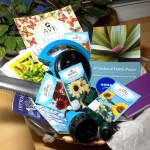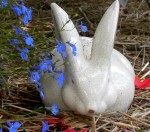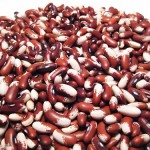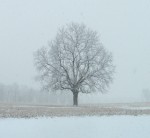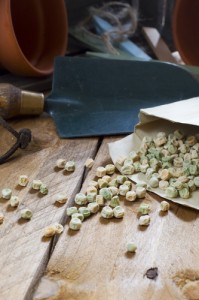 Most of us want our gardens to come back to life as soon as the snow is melted. Once the soil is thawed, you may be tempted to buy plants and get them in the ground, but resist the urge. For those of us in USDA Zone 5, we can still anticipate a hard frost, or freeze, until mid-May.
Most of us want our gardens to come back to life as soon as the snow is melted. Once the soil is thawed, you may be tempted to buy plants and get them in the ground, but resist the urge. For those of us in USDA Zone 5, we can still anticipate a hard frost, or freeze, until mid-May.
Another option to consider for your garden is direct seeding cold-hardy vegetables, herbs, annuals, and perennials. Many of these plants will do much better when the air and soil temperatures are cooler. And the costs of seeds are a lot less than flats of plants if you are on a tight budget.
Make sure your garden is not too wet to be worked. If you pick up a clump of soil and squeeze it and find it remains in a tight ball, or water drips out, it is too wet to be worked, so wait awhile. The soil is best worked when the clump of soil falls slightly apart after it is squeezed. Working a garden that is too wet will compact the soil and damage roots of existing plants.
As you prepare to plant, work in compost or peat moss. Lightly fertilize the soil where you plan to grow annuals and vegetables.
Direct seeding is easy. My technique is to scratch up a patch of soil to the depth as indicated on the seed packet, and sprinkle the seeds over top. I then take a handful of the soil and sprinkle this over the seeds and water lightly. To water lightly, use a misting head or fine sprinkler on the end of your hose. A spray bottle works well for small areas. I have found that a watering can with a sprinkling head often pours too harshly and the soil washes off, exposing the seeds.
If you want to plant in rows, make a shallow straight trench to the depth indicated on the seed packet—pile the soil to one side of the trench. Space the seeds as directed, and then push the piled soil over the seeds. Again, water lightly.
For seeds planted less than an inch deep, do not pat down the soil, as some gardeners do, I prefer to let the water settle the soil against the seeds instead.
Vegetables to plant by mid-April would include potatoes, onions, and garlic. You can now seed peas, plants in the cabbage family, Swiss chard, spinach, carrots, lettuce and arugula, radishes, beets, turnips and rutabaga.
It is also the time to direct seed perennial herbs such as chives, oregano, and sage.
Though still too early to plant for Zone 5, come May you can direct seed annual herbs parsley and dill. The annuals that can be direct seeded are snap dragons, petunias, calendula (some consider this an herb), stock, sunflowers and alyssum.
When it comes to perennial seeds, there are a lot to choose from. Some of the easiest to direct seed are blanket flower, black-eyed Susan, forget-me-nots (careful, these can become weedy), lupine, columbine, tickseed, coneflowers, and candytuft.
If you are someone who uses weed-inhibiting chemicals, such as Preen, remember that this product prevents any seed from taking root—including those you want to grow. Be sure to wait until after your seedlings have become well-rooted and sturdy-stemmed to spread the weed inhibitor.
It won’t be long until you see the seedlings pushing through the soil to become part of the joy you find in the garden.
(Image: Gardening – Pea Seeds by Space Monkey Pics, at shutterstock.com.)


